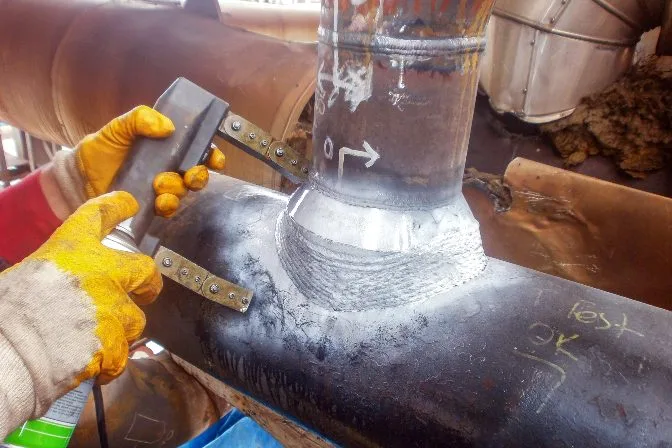Exactly How Tank Welding Inspection Avoids Future Structural Failures
Exactly How Tank Welding Inspection Avoids Future Structural Failures
Blog Article
An In-depth Summary of Container Welding Inspection Criteria and Methodologies for Improved Weld Top Quality and Efficiency
The value of welding inspection requirements in the production of containers can not be overstated, as they offer as the foundation for guaranteeing weld stability and functional dependability. Different inspection techniques, including aesthetic analyses and advanced non-destructive testing methods, are vital in recognizing possible flaws that could jeopardize efficiency.
Importance of Welding Inspection Standards

Welding assessment standards include a series of requirements, consisting of material specifications, welding treatments, and certifications of personnel entailed in the welding procedure. By implementing these requirements, organizations can methodically determine and rectify possible defects, consequently reducing the probability of expensive repairs or catastrophic failings. Extensive inspection methods promote a society of accountability and accuracy, encouraging welders to preserve high degrees of craftsmanship.

Usual Welding Examination Methods


Ultrasonic Testing (UT) is an additional widespread method, making use of high-frequency audio waves to find interior defects that may not be noticeable on the surface. This method is specifically reliable for determining voids or incorporations within the weld metal. Magnetic Particle Examining (MT) is likewise widely used, specifically for ferromagnetic materials, as it reveals surface area and near-surface problems through the application of magnetic areas and ferrous particles.
In Addition, Liquid Penetrant Screening (PT) finds surface-breaking problems by using a penetrant to the weld and then using a designer to extract the penetrant. Each of these strategies adds to a comprehensive assessment technique, guaranteeing that welds meet the rigid quality requirements required in container building and construction.
Regulatory Requirements and Compliance
Governing requirements and conformity are vital parts in guaranteeing the safety and security and reliability of welded frameworks in tank building - Tank Welding Inspection. These criteria serve to develop minimum needs for material residential properties, welding procedures, and assessment techniques, thus reducing the danger of architectural failings and enhancing general efficiency
Trick organizations, such as click over here now the American Society of Mechanical Engineers (ASME) and the American Welding Culture (AWS), give standards that are extensively adopted in the market. Conformity with these criteria not just ensures adherence to finest techniques yet also satisfies legal and legal commitments, safeguarding the interests of stakeholders.
Regulative bodies commonly mandate adherence to details codes, such as ASME Code best site Section IX for welding qualifications and API 650 for bonded containers. These codes outline requirements for welding techniques, qualifications of workers, and testing techniques to confirm weld stability.
Routine audits and assessments are essential to maintaining compliance, as they help identify discrepancies from developed requirements. Non-compliance can lead to considerable penalties, project hold-ups, and safety and security threats. Hence, a durable understanding of governing requirements and a dedication to conformity are paramount in accomplishing top notch and durable bonded tank frameworks.
Non-Destructive Evaluating Techniques
How can the integrity of bonded frameworks be guaranteed without causing damages? Non-destructive testing (NDT) approaches offer a durable service, enabling assessors to review weld high quality without jeopardizing the material - Tank Welding Inspection. Amongst one of the most typical NDT methods are ultrasonic testing (UT), radiographic screening (RT), magnetic particle screening (MT), and dye penetrant screening (PT)
Radiographic testing entails passing X-rays or gamma rays via the weld, creating images that disclose structural issues such as fractures or spaces. This technique is indispensable for examining the stability of complicated welds.
Magnetic bit screening is matched for ferromagnetic materials, where electromagnetic fields expose surface area and near-surface discontinuities. Dye penetrant screening utilizes a fluid color to highlight surface-breaking imperfections, making it an effective technique for non-porous products.
Each of these NDT methods has distinctive advantages, enabling comprehensive evaluations customized to specific materials and welding processes. By applying these techniques, markets can make sure the integrity and safety of welded frameworks, inevitably enhancing general efficiency.
Enhancing Weld Top Quality Through Evaluation
Efficient examination plays a crucial role in improving weld high quality, offering as an essential checkpoint in the fabrication process. By identifying prospective flaws early, assessments minimize the threat of compromised structural integrity and guarantee compliance with market requirements. Utilizing a mix of aesthetic assessments, non-destructive screening (NDT) techniques, and mechanical assessments, inspectors can discover problems such as porosity, fractures, and incomplete combination.
Executing a robust evaluation protocol not only improves the overall quality of welds yet additionally cultivates a society of responsibility among welders and producers. Routine training and accreditation of evaluation personnel ensure that they are equipped with the essential abilities to acknowledge and deal with possible issues successfully. This positive method decreases rework and connected costs, ultimately adding to predict effectiveness.
Additionally, comprehensive documents of assessment findings provides beneficial understandings into repeating issues, promoting constant improvement in welding methods. By leveraging innovative innovations, such as automated ultrasonic testing or electronic radiography, weld high quality can be enhanced via much more precise analyses. To conclude, a rigorous assessment process is important in achieving top notch welds, guaranteeing safety and security, reliability, and long life in tank manufacture.
Verdict
To conclude, the execution of Visit Your URL extensive container welding evaluation criteria and approaches is crucial for making sure weld honesty and performance. By utilizing a combination of visual assessments, non-destructive screening methods, and adherence to regulatory criteria, organizations can efficiently recognize and mitigate prospective issues. Promoting a society of liability among welders additionally boosts the quality of welding procedures. Ultimately, these practices contribute to minimized architectural failings, lower repair work expenses, and boosted functional performance within the industry.
Report this page